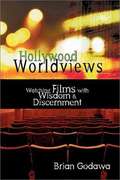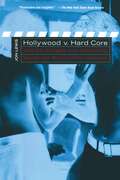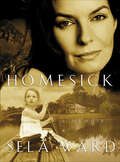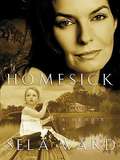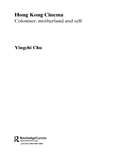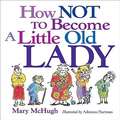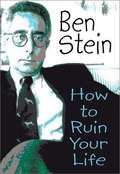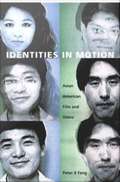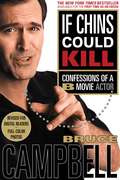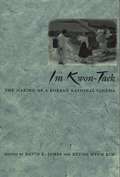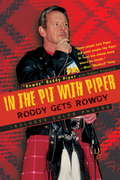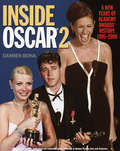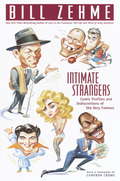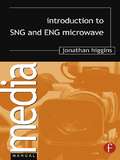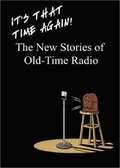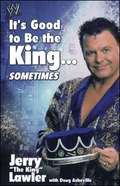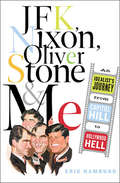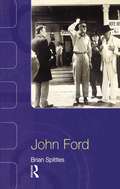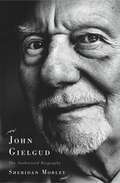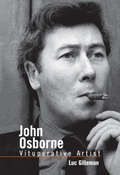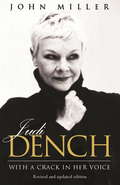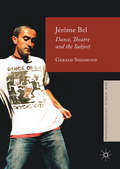- Table View
- List View
Hollywood Worldviews: Watching Films with Wisdom and Discernment
by Brian GodawaDo you watch movies with your eyes open? You buy your tickets and concessions, and you walk into the theater. Celluloid images flash at twenty-four frames per second, and the hypnotic sequence of moving pictures coaxes you to suspend disbelief and be entertained by the implausible. Unfortunately, many often suspend their beliefs as well, succumbing to subtle lessons in how to behave, think and even perceive reality. Do you find yourself hoping that a sister will succeed in seducing her sibling's husband, that a thief will get away with his crime, that a serial killer will escape judgment? Do you, too, laugh at the bumbling priest and seethe at the intolerant and abusive evangelist? Do you embrace worldviews that infect your faith and wonder, after your head is clear, whether your faith can survive the infection? Brian Godawa guides you through the place of redemption in film, the tricks screenwriters use to communicate their messages, and the mental and spiritual discipline required for watching movies. Hollywood Worldviews helps you enter a dialogue with Hollywood that leads to a happier ending, one that keeps you aware of your culture and awake to your faith.
Hollywood v. Hard Core: How the Struggle Over Censorship Created the Modern Film Industry
by Jon LewisA tale of censorship and regulation at the heart of the modern film industryIn 1972, The Godfather and Deep Throat were the two most popular films in the country. One, a major Hollywood studio production, the other an independently made "skin flick." At that moment, Jon Lewis asserts, the fate of the American film industry hung in the balance.Spanning the 20th century, Hollywood v. Hard Core weaves a gripping tale of censorship and regulation. Since the industry's infancy, film producers and distributors have publicly regarded ratings codes as a necessary evil. Hollywood regulates itself, we have been told, to prevent the government from doing it for them. But Lewis argues that the studios self-regulate because they are convinced it is good for business, and that censorship codes and regulations are a crucial part of what binds the various competing agencies in the film business together. Yet between 1968 and 1973 Hollywood films were faltering at the box office, and the major studios were in deep trouble. Hollywood's principal competition came from a body of independently produced and distributed films—from foreign art house film Last Tango in Paris to hard-core pornography like Behind the Green Door—that were at once disreputable and, for a moment at least, irresistible, even chic. In response, Hollywood imposed the industry-wide MPAA film rating system (the origins of the G, PG, and R designations we have today) that pushed sexually explicit films outside the mainstream, and a series of Supreme Court decisions all but outlawed the theatrical exhibition of hard core pornographic films. Together, these events allowed Hollywood to consolidate its iron grip over what films got made and where they were shown, thus saving it from financial ruin.
Holy Is the Lord (Expanded Edition)
by Jim CowanHoly is the Lord: Into Thy Presence (Vol 1), Lord, Draw Me Nearer (Vol 2), I Worship You (Vol 3), With All My Heart (Vol 4), Forever to Reign (Vol 5), In This Upper Room (Vol 6). Millennium III: Walk on Water (Vol 1), Awesome God (Vol 2), The Days of Elijah (Vol 3), I'm Trading My Sorrows (Vol 4), Jesus Lifted High (Vol 5)
Homesick: A Memoir
by Sela Ward“A lilting, loving memoir of the South and simpler days” from the vibrant and beloved star of Sisters and Once and Again (USA Today).“This is the story of a girl who grew up in a gentle town in the Deep South, cradled by family and friends, worshiping Bear Bryant on Saturday night and Jesus Christ on Sunday morning . . .”At a time when much of America is yearning to recapture the spirit and feelings of a more innocent era, comes this extraordinary memoir from one of our most beloved actresses: a story of reconnecting with the most important things in life.Millions of TV and film viewers know Sela Ward as the Emmy-winning star of the series Sisters and Once and Again. But before she became a successful actress, Sela was first and foremost a small-town girl, the daughter of a family that lived for generations in a Mississippi homestead they called “Homeward.” It was there, within a tightly knit community of neighbors and kin, that Sela learned ways that would remain with her through life-humble virtues, like generosity, selflessness, and respect, that are “forged in the hearth of a loving home.” Now she has woven together nostalgic reminiscences, stories from throughout her life and career, and lessons on drawing strength and wisdom from a simpler place and time, to give us Homesick: a very special book on the challenge of raising a family, maintaining perspective, and carving away time for happiness amid the challenges of modern life.“An ode to simpler, safer times that is likely to strike a chord among Americans in these unsettling days.” —The Baltimore Sun
Homesick: a Memoir
by Sela WardThough best known today as the Emmy Award-winning star of the television series Once & Again and Sisters, Sela Ward considers herself at heart a small-town girl. When her world was recently rocked by a crisis -- the death of her mother -- Sela's journey home to Meridian, Mississippi, became something far deeper: a turning point in her own life, as she pondered her mother's complicated legacy and came to terms with just what it was she herself was searching for. Filled with warmth, storytelling, and laughter, Homesick is a book to treasure: an exploration of the lessons we carry away with us from childhood, and a celebration of the bittersweet legacy of home.
Hong Kong Cinema: Coloniser, Motherland and Self
by Yingchi ChuExamining Hong Kong cinema from its inception in 1913 to the end of the colonial era, this work explains the key areas of production, market, film products and critical traditions. Hong Kong Cinema considers the different political formations of Hong Kong's culture as seen through the cinema, and deals with the historical, political, economic and cultural relations between Hong Kong cinema and other Chinese film industries on the mainland, as well as in Taiwan and South-East Asia. Discussion covers the concept of 'national cinema' in the context of Hong Kong's status as a quasi-nation with strong links to both the 'motherland' (China) and the 'coloniser' (Britain), and also argues that Hong Kong cinema is a national cinema only in an incomplete and ambiguous sense.
How Not to Become a Little Old Lady
by Mary MchughYou can be little, and you can be old, but that doesn't mean you have to be a Little Old Lady. We've all seen her. She's hunched forward, her blue hair is tucked neatly under a plastic rain bonnet, she's clutching expired coupons, and she's discussing her latest health problems over lunch. She's a Little Old Lady. . . and she's coming your way at two mph. Little Old Ladies have elastic waistbands on all their slacks. They save rubber bands, remember fifteen-cent McDonald's hamburgers, and have never seen a public rest room that was clean enough. How Not to Become a Little Old Lady is for any woman who is proud to have escaped Little Old Lady-hood, and it's for anyone in danger of slipping into those awful Little Old Lady tendencies.
How to Ruin Your Life
by Ben SteinAuthor Ben Stein offers a witty, humorous account of 35 "simple steps" on how you can quickly, easily, and effectively ruin your life.
Identities in Motion: Asian American Film and Video
by Peter X FengThis innovative book shows how Asian American filmmakers and videomakers frame and are framed by history--how they define and are defined by cinematic projections of Asian American identity. Combining close readings of films and videos, sophisticated cultural analyses, and detailed production histories that reveal the complex forces at play in the making and distributing of these movies, Identities in Motion offers an illuminating interpretative framework for assessing the extraordinary range of Asian American films produced in North America. Peter X Feng considers a wide range of works--from genres such as detective films to romantic comedies to ethnographic films, documentaries, avant-garde videos, newsreels, travelogues, and even home movies. Feng begins by examining movies about three crucial moments that defined the American nation and the roles of Asian Americans within it: the arrival of Chinese and Japanese women in the American West and Hawai'i; the incorporation of the Philippines into the U. S. empire; and the internment of Japanese Americans during World War II. In subsequent chapters Feng discusses cinematic depictions of ideological conflicts among Asian Americans and of the complex forces that compel migration, extending his nuanced analysis of the intersections of sexuality, ethnicity, and nationalist movements. Identities in Motion illuminates the fluidity of Asian American identities, expressing the diversity and complexity of Asian Americans--including Filipinos, Indonesians, Chinese, Japanese, Vietnamese, Laotians, Indians, and Koreans--from the nineteenth to the twenty-first century.
If Chins Could Kill: Confessions of a B Movie Actor
by Bruce CampbellIf Chins Could Kill: Confessions of a B Movie Actor Here we are together in the digital universe. Somehow, you've clicked yourself to this page. If you came here of your own free will and desire, you and I are going to get along just fine. Life is full of choices. Right now, yours is whether or not to download the autobiography of a mid-grade, kind of hammy actor. Am I supposed to know this guy? you think to yourself.No-and that's exactly the point. You can download a terabyte of books about famous actors and their high-falootin' shenanigans. I don't want to be a spoilsport, but we've all been down that road before. Scroll down to that Judy Garland biography. You know plenty about her already-great voice, troubled life. Scroll down a little further to the Charlton Heston book. Same deal. You know his story too-great voice, troubled toupee. The truth is that though you might not have a clue who I am-unless you watch cable very late at night-there are countless working stiffs like me out there, grinding away every day at the wheel of fortune. If Chins Could Kill: Confessions of a B Movie Actor documents my time in blue-collar Hollywood, where movies are cheap, the hours are long, and the filmmaking process can be very personal. To keep up with the times, I've digitized Chins. It was originally published in hardcover/analog fifteen years ago, which is a vast amount of time in the evolution of books and technology, and it was time to get current. The advance of technology is great for a book like this, which is jammed full of pictures. When it came out originally, the photographs all had to be black and white and moderately sized on the page. Now, any photo that was originally taken in color can strut its stuff. Overall, the resolution of the images is off-the-charts better than the first go-around. This is one "sequel" that I'm happy to be a part of, since we could make so many technical improvements. The process was very similar to restoring an old movie.Since I knew that it was going to be reissued, I also had a look at the story being told and decided to condense, move, or clarify some chapters, all or in part. I also tried to add a hint of historical context, since it has been a decade and a half since Chins first came out.I hope you enjoy it. Regards,Bruce Campbell
Im Kwon-Taek: The Making of a Korean National Cinema
by Kyung Hyun Kim David E. JamesKorean cinema was virtually unavailable to the West during the Japanese colonial period (1910-1945), and no film made before 1943 has been recovered even though Korea had an active film-making industry that produced at least 240 films. For a period of forty years, after Korea was liberated from colonialism, a time where Western imports were scarce, Korean cinema became an innovative force reflecting a society whose social and cultural norms were becoming less conservative. Im Kwon-Taek: The Making of a Korean National Cinema is a colleciton of essays written about Im Kwon-Taek, better know as the father of New Korean Cinema, that takes a critical look at the situations of filmmakers in South Korea. Written by leading Koreanists and scholars of Korean film in the United States, Im Kwon-Taek is the first scholarly treatment of Korean cinema. It establishes Im Kwon-Taek as the only major Korean director whose life's work covers the entire history of South Korea's military rule (1961-1992). It demonstrates Im's struggles with Korean cinema's historical contradictions and also shows how Im rose above political discord. The book includes an interview with Im, a chronology of Korean cinema and Korean history showing major dynastic periods and historical and political events, and a complete filmography. Im Kwon-Taek is timely and makes a significant contribution to our understanding of Korean cinema. These essays situate Im Kwon-Taek within Korean filmmaking, placing him in industrial, creative, and social contexts, and closely examine some of his finest films. Im Kwon-Taek will interest students and scholars of film studies, Korean studies, religious studies, postcolonial studies, and Asian studies.
In The Pit With Piper: Roddy gets Rowdy
by Robert Picarello Rowdy Roddy PiperHere, in his own words, is the story of one of the greatest wrestlers ever-Rowdy Roddy Piper. The bagpipe-playing legend gets down and dirty about the world of professional wrestling-and his own career. He takes readers back to his life as a teenage runaway and his first match, when he stepped into the ring for $25. He recalls his triumph as the youngest World Light Heavyweight Champion, and how he helped make the World Wrestling Federation the phenomenon it is today with little more than a microphone stand and a bow tie. From a man who joined the game long before it emerged as big-time entertainment comes a story that tells it like it is-and that's filled with as much excitement as the jam-packed arenas where he fought his fiercest foes.
Inner Sanctum Mysteries: Behind the Creaking Door
by Martin GramsInner Sanctum Mystery is considered by many as the founding father of radio horrors. Known for its signature opening creaking door, Raymond the host invited listeners in for a weekly half-hour fright fest of murder and madness. Werewolves, vampires, creeping vines, walking corpses, evening storms, haunted houses, black cats, vengeful ancestors, and even ghosts roamed the airwaves. For eleven seasons this horror program frightened listeners and today, the program remains one of the best-known radio horrors of the Twentieth Century. Horror stars Boris Karloff, Peter Lorre and Lon Chaney, Jr. Were the star figures in these classics, along with Frank Sinatra, Agnes Moorehead, Judith Evelyn, Ralph Bellamy, Donald Buka, and many others. This book documents the history of this horror program, including an episode guide for the radio series and television programs, documentation of the horror movies, and a listing of the Simon & Schuster mystery novels. Years of research and a wealth of information can be found within these pages-making this book a "must have" for every old-time radio fan.
Inside Oscar 1995-2000
by Damien BonaFINALLY, A SEQUEL AS GOOD AS THE ORIGINAL! Enlivened by humorous incidents, brewing controversies, and deeply moving personal dramas, Inside Oscar 1995-2000 offers the complete lowdown on six more years of Academy Awards glory ... from Braveheart in 1995 through Gladiator in 2000, with the Titanic phenomenon and the Saving Private Ryan/Shakespeare in Love feud in between. There is also complete coverage of the awards ceremonies?with delicious anecdotes on the presenters and performers, the producers and egos, the fashion stars and fashion victims. And, of course, a complete list of all the nominees and winners, as well as a list of notable non-nominees. Picking up where the classic Inside Oscar leaves off, this must-have guide treats us to a behind-the-scenes look at one of America's most beloved annual traditions!
Intimate Strangers: Comic Profiles and Indiscretions of the Very Famous
by Bill ZehmeSchwarzenegger intimidates. Sharon Stone strips. Leno and Letterman duel. In twenty years of raw and raucous celebrity profiles Irreverently bold journalist Bill Zehme has long been celebrated for his ability to get under the skins of our most elusive icons, from the evasive Warren Beatty to the ever-unpredictable Madonna to the much misunderstood Barry Manilow. Now his most provocative work is collected for the first time, with over twenty-five landmark profiles, including Frank Sinatra, Tom Hanks, Jerry Seinfeld, Liberace, Howard Stern, Eddie Murphy, and Woody Allen. Zehme witnesses Hugh Hefner withstanding the single blow that never entered into an adolescent boy's dreams--losing his fantasy woman. He gets a nude massage with Sharon Stone, and an earful about men, sex, and the shotgun she keeps under her bed. Included, too, is Zehme's exclusive firsthand coverage of David Letterman and Jay Leno, before and throughout their late-night feud. Here is entertainment history through the eyes of a man the Chicago Tribune called "one of the most successful and prolific magazine writers in the country. " Hilarious, endearing, and wickedly insightful,Intimate Strangerscaptures the business of celebrity for what it is: a big, lusty, star-crossed love affair between our icons and ourselves.
Introduction to SNG and ENG Microwave
by Jonathan HigginsAn excellent primer on the subject, this book gives beginning professionals in satellite newsgathering an introduction to the technologies and processes involved. It will also suit journalists, editors and producers needing to understand this important element of the newsgathering chain. Written for the complete beginner, the book shows how typical transmission chains work and their communication with the studio. It also offers a brief introduction to analogue and digital theory before going onto to explain Electronic Newsgathering (ENG) systems: from basic principles: transmission and reception chains, frequencies used and why, through to audio channel, subcarriers and digital modulation, as well as applications: radio cameras, window links, infra-red & laser links.A brief chapter on satellite theory gives an overview of satellite communication and orbits, basic satellite communication theory, transportables (`flyaways') and trucks, as well as analogue vs digital issues, digital compression and MPEG. Systems regulations and operations are also introduced as well as safety and logistics issues.If you're looking for a quick and easy introduction to the subject, this book will act as an essential on the job reference guide.
Isabel: Taking Wing (Girls Of Many Lands)
by Annie DaltonIn 1592, twelve-year-old Isabel dreams of adventure and finds it, not only on her journey from her London home to her aunt's manor house in Northamptonshire, but also through the healing arts her aunt teaches her.
It's That Time Again! The New Stories of Old-Time Radio
by Ben OhmartNEW stories of old-time radio, written by today's most knowledgable OTR authors and fans.
It’s Good to Be the King... Sometimes
by Jerry "The King" LawlerJerry Lawler is hailed as one of sports-entertainment's most enduring and colorful characters. His life has been filled with hilarious, never-been-told stories... until now! His reign consists of thirteen championships (one of which he's held more than forty times), three marriages, and two children. He's dominated Memphis radio and television airwaves. Starred in feature films. Recorded albums. Tolerated countless sprains, broken bones, concussions, and contusions. The way Jerry "The King" Lawler tells it, if you're good at something, do it more than once. It's Good To Be The King... Sometimes is a no-holds-barred personal account from the "puppies"-pantin' King of one-liners, who steps out from behind the announcer's desk of WWE Raw to hold court about everything. His passion for art that first drew him to the ring of a rundown West Memphis movie theater over thirty years ago. The comic adventures and tragic bumps endured journeying down the "Music Highway" of Interstate 40 with the National Wrestling Alliance. Earning his royal personage in the Bluff City of the Mighty Mississippi against his own mentor, "Fabulous" Jackie Fargo. Grappling with mat legends Ric Flair, Lou Thesz, Jesse Ventura, Andre the Giant, Terry Funk, and Bret "Hitman" Hart. And his crowning achievements as co-ruler of the United States Wrestling Association, which contributed to the rise of future WWE Superstars Hulk Hogan, Undertaker, Stone Cold Steve Austin, and The Rock. It's time you lackeys pay heed as the King reveals the schemes and outrageous story lines to many of wrestling's most fantastic theatrics and all-too-real moments. Lawler tells of his legendary "feud" with Andy Kaufman, and his much-publicized confrontation with the actor portraying the late comedian on the set of Man on the Moon,and the "Karate-versus-Wrestling" match that almost occurred between Lawler and Memphis's other King. And be sure to honor his royal proclamations regarding former wives, and his mother's opinion of wrestling; why he once sued future boss Vince McMahon... and won; and the body part he truly worships on a WWE Diva.
JFK, Nixon, Oliver Stone and Me: An Idealist's Journey From Capitol Hill To Hollywood Hell
by Eric HamburgJFK, Nixon, Oliver Stone and Me is the funny, thoughtful memoir of an accomplished former Congressional staffer who left D. C. for Hollywood and a job with Oliver Stone, hoping to help make politically
John Ford (On Directors)
by Brian SpittlesJohn Ford is a monumental figure in Hollywood and world cinema. Throughout his long and varied career spanning the silent and sound era, he produced nearly 150 films of which Iron Horse (1924), Stagecoach (1939), The Grapes of Wrath (1940), How Green Was My Valley (1941), The Searchers (1956) and The Man Who Shot Liberty Valance (1962) are classics of cinema. Ford was also an influential figure in developing, and extending Hollywood's traditions. Stylistically Ford was instrumental in developing new camera techniques, atmospheric lighting and diverse narrative devices. Thematically, long before it became conventional wisdom, Ford was exploring issues that concern us today, such as gender, race, the treatment of ethnic minorities and social outcasts, the nature of history and the relationship of myth and reality. For all these reasons, John Ford the man and his films reward thought and study, both for the general reader and the academic student. Ford's pictures express the world in which they were made, and have contributed to making what Hollywood is today. This book illustrates the excitement, importance, influence, creativity, deviousness and complexity of the man and his films.
John Gielgud: The Authorized Biography
by Sheridan MorleySir John Gielgud's career as an actor was perhaps the most distinguished of any of his generation, and, in a lifetime that spanned almost a century, he appeared in hundreds of theatrical productions and films, receiving virtually every honor given, including an Academy Award.Now, in this wonderfully insightful biography, fully authorized and written with first-ever access to Gielgud's personal letters and diaries, bestselling biographer Sheridan Morley not only traces the actor's fascinating career, but provides a fresh and remarkably frank look into John Gielgud the man, showing how his success as an actor in many ways came at the expense of his personal happiness.Born into a theatrical family, John Gielgud took to the stage as naturally as a duck to water, and almost from the beginning, those who saw him perform knew that they were experiencing something extraordinary. A determined actor, intent on learning and polishing his craft, he worked incessantly, taking on one role after another, the greater the challenge, the better.During his long and remarkable career, he took on every truly great and demanding role, including all of Shakespeare's major plays as well as many contemporary and experimental productions. At ease in both great drama and light comedy, he was blessed with a great range and a seemingly infinite capacity to inhabit whatever character he attempted.Basically a somewhat shy man offstage, however, Gielgud for the most part limited his friendships to those with whom he worked, and as a result the theater -- and later, film -- made up just about his entire life. That he was flesh and blood, however, was reflected in the fact that he did enter into two long-term relationships, the first with a man who eventually left him for another, but with whom Gielgud maintained a strong tie, and the second with a handsome, mysterious Hungarian who lived with him until he died, just a few months before Sir John.True scandal came into Gielgud's life only once. In 1953, just weeks after Gielgud had been knighted by the Queen, he was arrested in a public men's room and charged with solicitation. The British press had a field day, but Gielgud's friends and fellow actors rallied to his support, as did his thousands of fans, and the result was the eventual change of law in England regarding sex between consenting adults.While these and many other aspects of his personal life are discussed for the first time in this distinguished biography, it is Gielgud's career as an actor, of course, that receives the greatest attention. And while British audiences had the pleasure of seeing him perform in the theater for his entire life, Americans came to know him best for his work in the movies, and most especially for his Oscar-winning performance as Hobson the butler in the Dudley Moore film Arthur.As dramatic and captivating as one of Sir John's many performances, this authorized biography is an intimate and fully rounded portrait of an unforgettable actor and a remarkable man.
John Osborne: Vituperative Artist (Studies in Modern Drama)
by Luc GillemanFor British playwright, John Osborne, there are no brave causes; only people who muddle through life, who hurt, and are often hurt in return. This study deals with Osborne's complete oeuvre and critically examines its form and technique; the function of the gaze; its construction of gender; and the relationship between Osborne's life and work. Gilleman has also traced the evolution of Osborne's reception by turning to critical reviews at the beginning of each chapter.
Judi Dench: With A Crack In Her Voice
by John MillerThe first full biography of Britain's leading actress of her time.Whether it is her sunny temperament, her gift of laughter, her wide-ranging abilities, or all three, Judi Dench is without doubt a star. Shortlisted for a 1998 Oscar for her performance as Queen Victoria in MRS BROWN, she then won one for her role as Queen Elizabeth in SHAKESPEARE IN LOVE. Judi Dench is widely loved, and not only among the theatrical profession. Her long-running appearance opposite Geoffrey Palmer in the TV situation comedy AS TIME GOES BY has run to four series and gained her a TV TIMES readers' award as ¿the actress we most wish see more often on television¿. She juggles the National Theatre (a sell-out season in Sondheim's A LITTLE NIGHT MUSIC and David Hare's AMY'S VIEW) with TV and films (she is now established as 'M' in the latest James Bond series).Since the paperback edition was published, John Miller has written a new chapter, bringing what is fast becoming a classic biography completely up-to-date.
Jérôme Bel: Dance, Theatre, and the Subject (New World Choreographies)
by Gerald SiegmundThis study is the first monograph on the work of French choreographer Jérôme Bel, following his artistic trajectory from the beginning of his career as a choreographer in 1994 to his most recent piece in 2016. It contains an overview and in-depth analysis of all of his choreographies, from Nom donné par l’auteur to Disabled Theatre, and provides a theoretical reflection on their theatrical nature.Bel has developed a singular discourse on dance that has often been labelled 'conceptual'. By reducing the stage elements in his performances to a minimum, his work explores the implications of dance as an art form that has, since the heyday of modernism, based its guiding principles on the laws of nature. Bel addresses the question of power relations in dance by working through the questions of authorship and various forms of subjectivity dance produces. Offering a unique opportunity to ground seemingly abstract academic theories in a specific embodied artistic practice, this study explores the intersection between artistic practice and theory.
